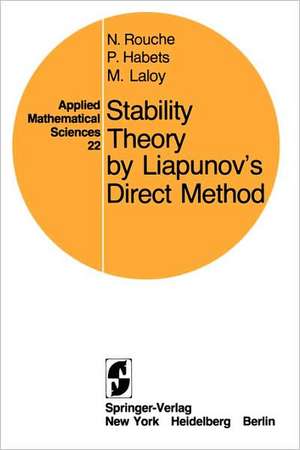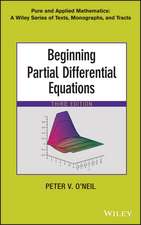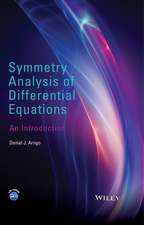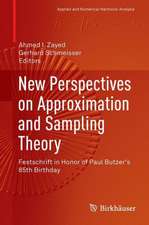Stability Theory by Liapunov’s Direct Method: Applied Mathematical Sciences, cartea 22
Autor Nicolas Rouche, P. Habets, M. Laloyen Limba Engleză Paperback – 9 iul 1977
Din seria Applied Mathematical Sciences
- 13%
 Preț: 426.94 lei
Preț: 426.94 lei - 13%
 Preț: 426.46 lei
Preț: 426.46 lei - 13%
 Preț: 427.63 lei
Preț: 427.63 lei - 9%
 Preț: 1728.59 lei
Preț: 1728.59 lei - 24%
 Preț: 906.80 lei
Preț: 906.80 lei - 23%
 Preț: 659.07 lei
Preț: 659.07 lei -
 Preț: 375.65 lei
Preț: 375.65 lei - 18%
 Preț: 909.47 lei
Preț: 909.47 lei - 18%
 Preț: 795.02 lei
Preț: 795.02 lei - 18%
 Preț: 950.52 lei
Preț: 950.52 lei - 15%
 Preț: 645.47 lei
Preț: 645.47 lei - 20%
 Preț: 755.49 lei
Preț: 755.49 lei -
 Preț: 382.67 lei
Preț: 382.67 lei - 24%
 Preț: 808.06 lei
Preț: 808.06 lei -
 Preț: 452.62 lei
Preț: 452.62 lei -
 Preț: 190.23 lei
Preț: 190.23 lei -
 Preț: 399.12 lei
Preț: 399.12 lei - 18%
 Preț: 966.90 lei
Preț: 966.90 lei - 15%
 Preț: 643.48 lei
Preț: 643.48 lei - 15%
 Preț: 528.80 lei
Preț: 528.80 lei -
 Preț: 413.15 lei
Preț: 413.15 lei -
 Preț: 390.25 lei
Preț: 390.25 lei - 18%
 Preț: 736.01 lei
Preț: 736.01 lei - 18%
 Preț: 1411.05 lei
Preț: 1411.05 lei - 15%
 Preț: 711.21 lei
Preț: 711.21 lei -
 Preț: 395.47 lei
Preț: 395.47 lei - 18%
 Preț: 1017.26 lei
Preț: 1017.26 lei -
 Preț: 403.15 lei
Preț: 403.15 lei - 18%
 Preț: 1130.14 lei
Preț: 1130.14 lei - 18%
 Preț: 1134.87 lei
Preț: 1134.87 lei - 18%
 Preț: 1329.00 lei
Preț: 1329.00 lei - 18%
 Preț: 1129.65 lei
Preț: 1129.65 lei - 18%
 Preț: 1140.71 lei
Preț: 1140.71 lei
Preț: 361.66 lei
Nou
Puncte Express: 542
Preț estimativ în valută:
69.21€ • 74.00$ • 57.70£
69.21€ • 74.00$ • 57.70£
Carte tipărită la comandă
Livrare economică 17 aprilie-01 mai
Preluare comenzi: 021 569.72.76
Specificații
ISBN-13: 9780387902586
ISBN-10: 0387902589
Pagini: 396
Ilustrații: XII, 396 p.
Dimensiuni: 155 x 235 x 21 mm
Greutate: 0.58 kg
Ediția:Softcover reprint of the original 1st ed. 1977
Editura: Springer
Colecția Springer
Seria Applied Mathematical Sciences
Locul publicării:New York, NY, United States
ISBN-10: 0387902589
Pagini: 396
Ilustrații: XII, 396 p.
Dimensiuni: 155 x 235 x 21 mm
Greutate: 0.58 kg
Ediția:Softcover reprint of the original 1st ed. 1977
Editura: Springer
Colecția Springer
Seria Applied Mathematical Sciences
Locul publicării:New York, NY, United States
Public țintă
ResearchCuprins
I. Elements of Stability Theory.- 1. A First Glance at Stability Concepts.- 2. Various Definitions of Stability and Attractivity.- 3. Auxiliary Functions.- 4. Stability and Partial Stability.- 5. Instability.- 6. Asymptotic Stability.- 7. Converse Theorems.- 8. Bibliographical Note.- II. Simple Topics in Stability Theory.- 1. Theorems of E.A. Barbashin and N.N. Krasovski for Autonomous and Periodic Systems.- 2. A Theorem of V.M. Matrosov on Asymptotic Stability.- 3. Introduction to the Comparison Method.- 4. Total Stability.- 5. The Frequency Method for Stability of Control Systems.- 6. Non-Differentiable Liapunov Functions.- 7. Bibliographical Note.- III. Stability of a Mechanical Equilibrium.- 1. Introduction.- 2. The Lagrange-Dirichlet Theorem and Its Variants.- 3. Inversion of the Lagrange-Dirichlet Theorem Using Auxiliary Functions.- 4. Inversion of the Lagrange-Dirichlet Theorem Using the First Approximation.- 5. Mechanical Equilibrium in the Presence of Dissipative Forces.- 6. Mechanical Equilibrium in the Presence of Gyroscopic Forces.- 7. Bibliographical Note.- IV. Stability in the Presence of First Integrals.- 1. Introduction.- 2. General Hypotheses.- 3. How to Construct Liapunov Functions.- 4. Eliminating Part of the Variables.- 5. Stability of Stationary Motions.- 6. Stability of a Betatron.- 7. Construction of Positive Definite Functions.- 8. Bibliographical Note.- V. Instability.- 1. Introduction.- 2. Definitions and General Hypotheses.- 3. Fundamental Proposition.- 4. Sectors.- 5. Expellers.- 6. Example of an Equation of N Order.- 7. Instability of the Betatron.- 8. Example of an Equation of Third Order.- 9. Exercises.- 10. Bibliographical Notes.- VI. A Survey of Qualitative Concepts.- 1. Introduction.- 2. A View of Stability and Attractivity Concepts.- 3. Qualitative Concepts in General.- 4. Equivalence Theorems for Qualitative Concepts.- 5. A Tentative Classification of Concepts.- 6. Weak Attractivity, Boundedness, Ultimate Boundedness.- 7. Asymptotic Stability.- 8. Bibliographical Note.- VII. Attractivity for Autonomous Equations.- 1. Introduction.- 2. General Hypotheses.- 3. The Invariance Principle.- 4. An Attractivity and a Weak Attractivity Theorem.- 5. Attraction of a Particle by a Fixed Center.- 6. A Class of Nonlinear Electrical Networks.- 7. The Ecological Problem of Interacting Populations.- 8. Bibliographical Note.- VIII. Attractivity for Non Autonomous Equations.- 1. Introduction, General Hypotheses.- 2. The Families of Auxiliary Functions.- 3. Another Asymptotic Stability Theorem.- 4. Extensions of the Invariance Principle and Related Questions.- 5. The Invariance Principle for Asymptotically Autonomous and Related Equations.- 6. Dissipative Periodic Systems.- 7. Bibliographical Note.- IX. The Comparison Method.- 1. Introduction.- 2. Differential Inequalities.- 3. A Vectorial Comparison Equation in Stability Theory.- 4. Stability of Composite Systems.- 5. An Example from Economics.- 6. A General Comparison Principle.- 7. Bibliographical Note.- Appendix I. DINI Derivatives and Monotonic Functions.- 1. The Dini Derivatives.- 2. Continuous Monotonic Functions.- 3. The Derivative of a Monotonic Function.- 4. Dini Derivative of a Function along the Solutions of a Differential Equation.- Appendix II. The Equations of Mechanical Systems.- Appendix III. Limit Sets.- List of Examples.- Author Index.











